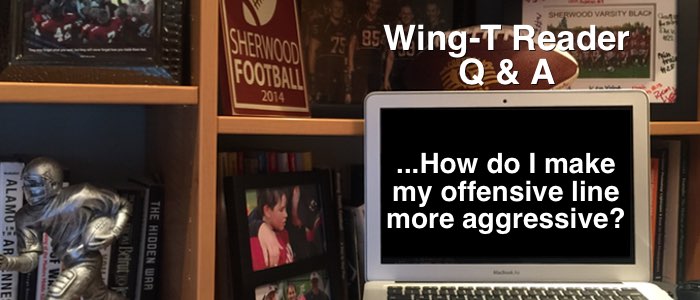How Can You Make Your Wing-T Line More Aggressive?

A reader recently asked:
I would like my offensive line to be more aggressive and quick. What would you do to get them there?
I’ll be the first to say that I’d go to a clinic to learn the secret recipe to how to make players “more aggressive”. I’ve been trying to crack that code for a while. The easy way out is to say that players got it or they don’t, but I think there are things we can do to help at least make the appearance of being more aggressive. And hopefully help them be more effective.
Your first objective should be to gradually build their confidence with fundamentals and repetition. This is similar to how we teach tackling now by gradually increasing levels of contact and not progressing until we see success at each level.
As far as progression, I recommend the following:
- Success starts with a good first step. So many problems I end up diagnosing can be traced back to improper first steps: the wrong foot, too big a step, or a false step. For Wing-T coaches start with down/gap blocking and practice those first steps over and over.
- Next is body position and pad level on the transition from the first step to second step. I teach bringing the hands back to the hips (“hands to holsters”), low pad level, and chest centered right over the knee of the first foot.
- Then move on to fitting the defender. I like to teach “hands to shoulder” with hands striking hip to chest level followed by fitting up on the proper shoulder.
- Finally, drive the defender. In the Wing-T this is more often down the line of scrimmage and not downfield. Drive the defender 5 yards, driving feet and moving lower body
My experience is that you need a lot of repetition of each of these steps individually as well as piecing them together. You’ll see regression as you focus on the full progression - first steps will get too big, they’ll focus too much on hands and ignore shoulder, they won’t want to drive 5 yards, etc. Work on this like you do everything else in football: when results start to deteriorate, you go back to rebuilding the progression.
How does all of this lead to more quickness and aggression? Because the more muscle memory your players develop, the less they have to think, and the more instinctive their movements become. I think this is most important for gap and down blocks where a small mistake can mean a run-through by a linebacker.
Let’s assume you’ve installed with this progression and things look good in practice. Yet you aren’t seeing great results in the game. It can be easy to jump to conclusions – for example, maybe your tackle got blown up on one play because he stood straight up at the snap, and this stands out in your mind because it happened right in front of you on the sideline. Or, at the other end of the spectrum, maybe you saw a great down block by your tight end and you assume that his performance was good throughout the game.
You need a more objective approach, and your players deserve effective, timely feedback on their performance. I recommend grading your players at least two times during the season. This might be after the 2nd or 3rd game, and near the end of the regular season as you prepare for the post season. I believe in seeing a body of work, evaluating dispassionately, and having a frank conversation with each player about their performance. Even your best players will have off plays and when you grade them like this you can give specific clips for them to watch. This sort of tangible, timely feedback will have a much greater impact than vague words from you.